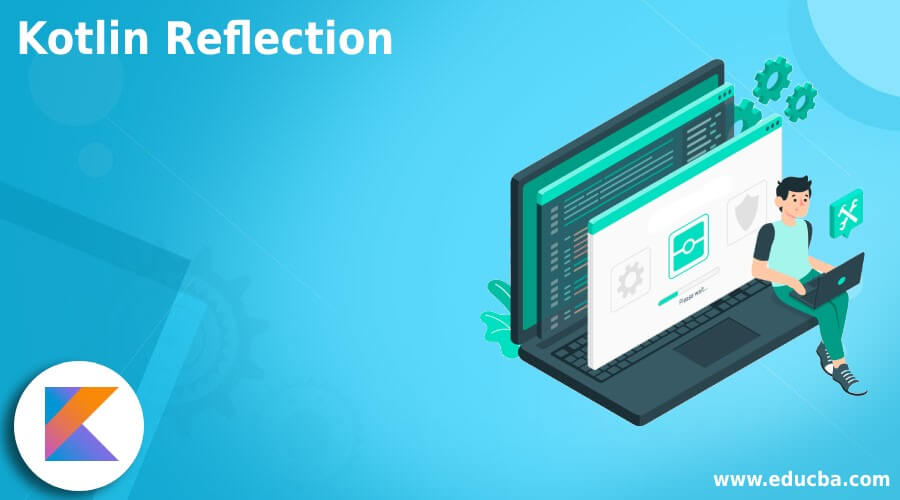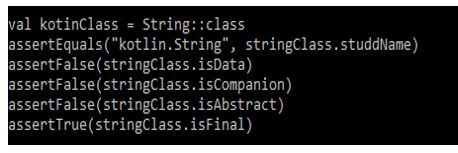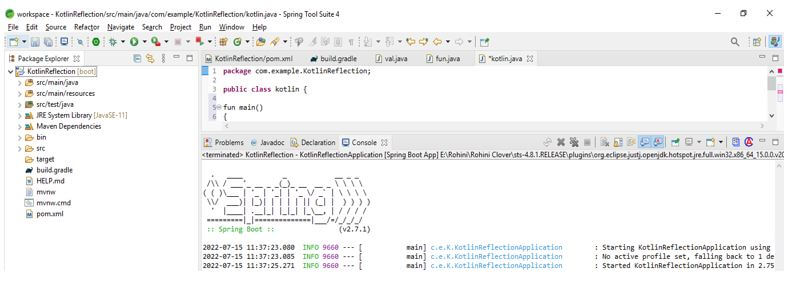Updated March 2, 2023
Introduction to Kotlin Reflection
Kotlin reflection is a set of library and language features that allow us to introspect the program structure. The properties and functions are the kotlin’s first-class citizens, and it was the ability for introspecting them. It is a feature that provides the feature for introspecting the given program. It is used for utilizing members and classes of its functions, properties, and constructors at runtime. By using the reflection API of java, kotlin is providing its set of API of reflection into function style which was simple, it is very useful and important in kotlin language.
What is Kotlin Reflection?
The standard construction of java reflection is also available in the kotlin and it will be working perfectly by using its code. Reflection will inspect the name of the ability; it will interact with the fields, methods, and classes at runtime. It contains a large number of uses which depends on what we are developing. Almost all frameworks’ libraries utilize the reflection of power under the hood. Into the kotlin reflection will enable us to refer to the statistically defines functions, classes, and interfaces at runtime. We can access the properties and functions of the access modifier class using it.
Kotlin Reflection Class References
To obtain the class references into the kotlin at runtime, which is statistically known, we need to use the operator of the class reference. Also, the reference class is obtained from the class of the instance. The reference of the class is known as references of bounded class. Using instances, we can obtain the reference of the exact type for which the object will confirm in case of an inheritance. Basically, class reference is used for obtaining the reference class object, for obtaining the reference object statistically in kclass. We need to use the class literal. The reference value of the type class is kclass. Kotlin class reference is not the same as a reference of java class. We are obtaining the reference of the java class by using kclass reference and property of java.
Below syntax shows the reference of class as follows:
Syntax:
val p1 = string::class
val p2 = kotlinclass::classThe reference API allows access to the reference class, we can use the same in the kotlin class, it will give access to the reference of the java class. We can access the extension method of the kotlin class by using the:: operator as follows.
Code:
val kotlinClass: Kclass <List> = List::class
val studname = "ABC"
val stringClass : KClass<String> = studname::class
val refClass: Class<MyType>
val kotlinClass: KClass<MyType> = refClass.kotlin.Output:
Once we obtain the object of kclass, we can easily find that our class is final or abstract. We can also find that our class is a data class or companion class.
Code:
val kotinClass = String::class
assertEquals ("kotlin.String", stringClass.studdName)
assertFalse (stringClass.isData)
assertFalse (stringClass.isCompanion)
assertFalse (stringClass.isAbstract)
assertTrue (stringClass.isFinal)Output:
Kotlin will add the ability to obtain the class hierarchy object of companion and an arbitrary class as follows.
Code:
println(refWithCompanion::class.cObject)
println(refWithCompanion::class.cObjInstance)
println(refObject::class.objInstance)Output:
In the below example, we are creating a new instance class by using the reference class as follows.
Code:
val kotlinClass = ArrayList::class
val kotlin = kotlinClass.createInstance()
assertTrue(list)Output:
In the below example, we are accessing the constructor to use it explicitly as follows.
Code:
val refClass = ref::class
println(refClass.constructors)
println(refClass.functions)
println(refClass.memberProperties)Output:
The most basic feature of getting the reference to a class of kotlin. Obtaining the reference statistically is known as the class of kotlin. We can get the class reference for the specific object with the::class syntax by using the receiver object as follows.
val ref: ref = ….
assert (ref is ref) { "Bad ref: ${ref::class.studName}" }We will obtain the reference of the exact class for an object ref or bad ref, instead of the type of receiver expression i.e. ref. References to the constructors, properties, and functions are called the function type instance.
Below example shows class references as follows:
Code:
class kotlin {
fun main()
{
val ref = kotlinref::class
……
val obj = kotlinref();
…….
} }Output:
Features of Kotlin Reflection
Reflection is the process of modifying and analyzing the runtime class’s capabilities at runtime. It is used for manipulating the class and its members, which includes function properties and constructor.
- We are using it for the creating class instance; using kotlin reflection, we can implement the class.
- Using it, we can invoke the lookup function and use the same in our program.
- We can inspect the annotation by using it.
- We can use it to discover the parameter and find the generic properties.
- Using kotlin, we can use two types of reflection java reflection AP and kotlin reflection API.
- We use the Java reflection API when we use the Java libraries on which java reflection is present.
- Reflection of kotlin is present in the package of kotlin. Reflect.
- Using it, we can give access to nullable types and properties not present in java.
- We can say that it is not a replacement for java reflection, but it contains additional features.
- We can use it to access the JVM code written using language.
- By using a kotlin reference, we can obtain a functional reference for every named function which was defined in a kotlin. We can do the same by preceding the name of the function with:: the operator.
- The functional reference is used as parameters for other functions; in this condition, we can specify the overload function explicitly or we can also specify the function implicitly, which was determined by content.
- In it we can also obtain the property reference in a similar fashion as we are using the:: operator, this property belongs to the class of kotlin reflection.
Conclusion
By using the reflection API of java, kotlin is providing its set of API of reflection into function style, which was simple; Kotlin reflection is very useful and important in kotlin language. Kotlin reflection is a library and language feature set that allows us to introspect the program structure.
Recommended Articles
This is a guide to Kotlin Reflection. Here we discuss the introduction, kotlin reflection class references and features, respectively. You may also have a look at the following articles to learn more –








